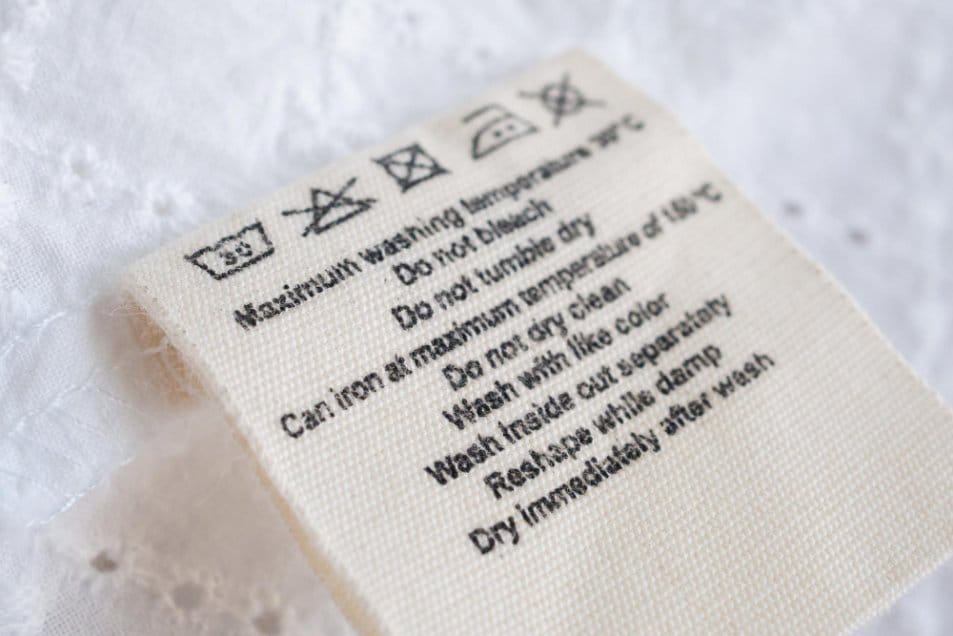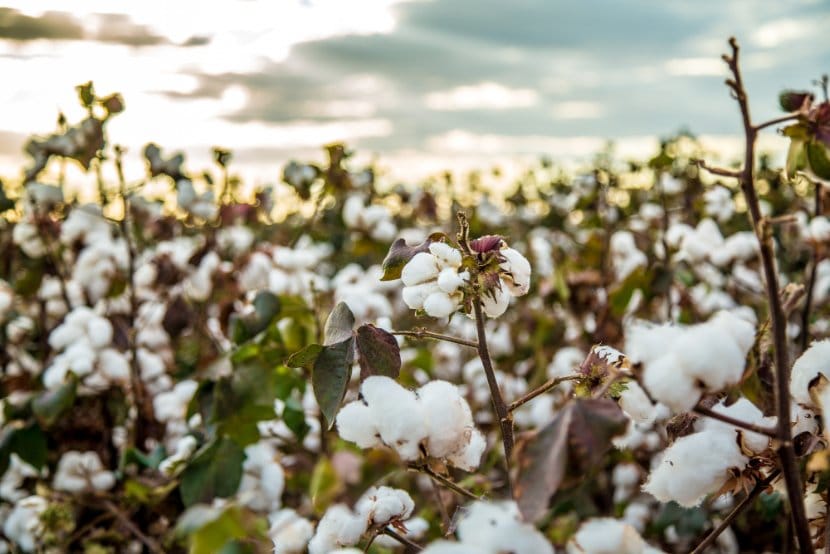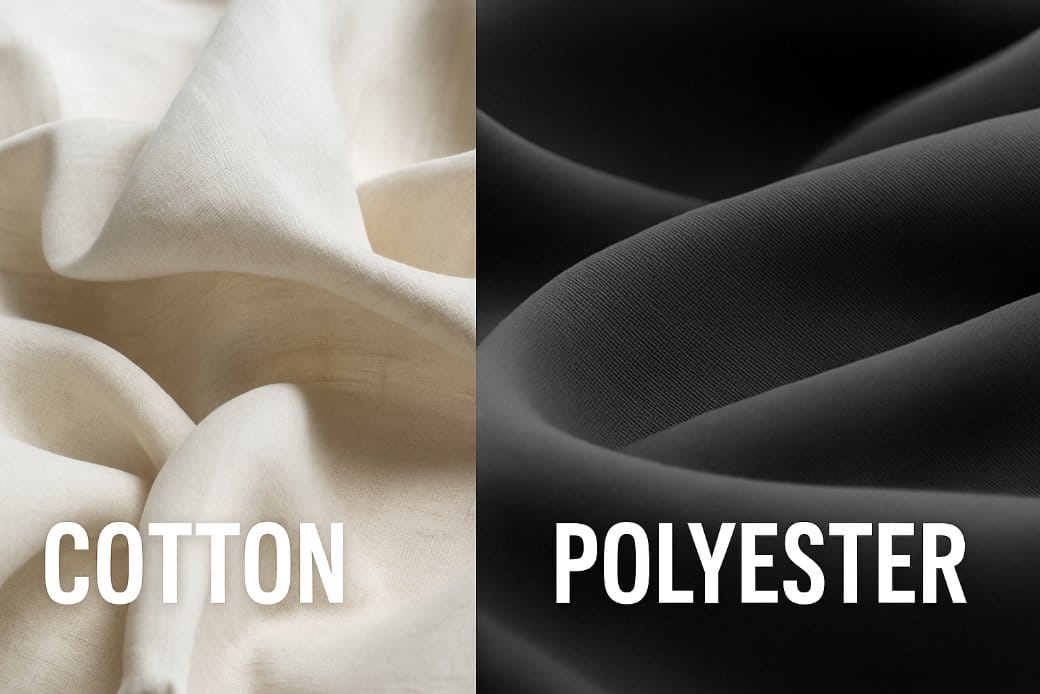Essential Cotton Fabric Care: Expert Tips for Washing, Drying, and Storing Your Cotton Clothes
Cotton is hands down one of the most popular fabrics in our closets. From your favorite t-shirt to those comfy bed sheets, cotton surrounds us every day. But here’s the thing – taking good care of your cotton items isn’t just about tossing them in the washing machine and hoping for the best.
When you know how to properly care for cotton, your clothes will stay soft, vibrant, and comfortable for years. The best part? It’s easier than you might think. Whether you’re dealing with 100% cotton fabrics or cotton blends, this guide will walk you through everything you need to know.
The key to maintaining cotton items is simple: wash them in warm or cold water, dry on medium heat, and iron while slightly damp for the best results. Proper cotton care involves straightforward steps that protect the fabric’s natural properties and extend its lifespan.
Why Cotton Care Matters
Your cotton clothes deserve attention during washing and storage. When you follow basic care guidelines, you can prevent common problems like shrinkage, fading, and fabric damage that often affect cotton items. Plus, well-cared-for cotton actually gets softer and more comfortable over time.
Key Takeaways
- Regular maintenance with proper washing and drying temperatures keeps cotton soft and durable
- Checking care labels and sorting clothes by color prevents damage and maintains fabric quality
- Proper storage in cool, dry places extends cotton garment life and prevents mildew
Want personalized care recommendations? Use our Cotton Care Calculator to get optimal washing temperatures and care instructions based on your specific fabric blend and priorities.
Understanding Cotton and Its Properties
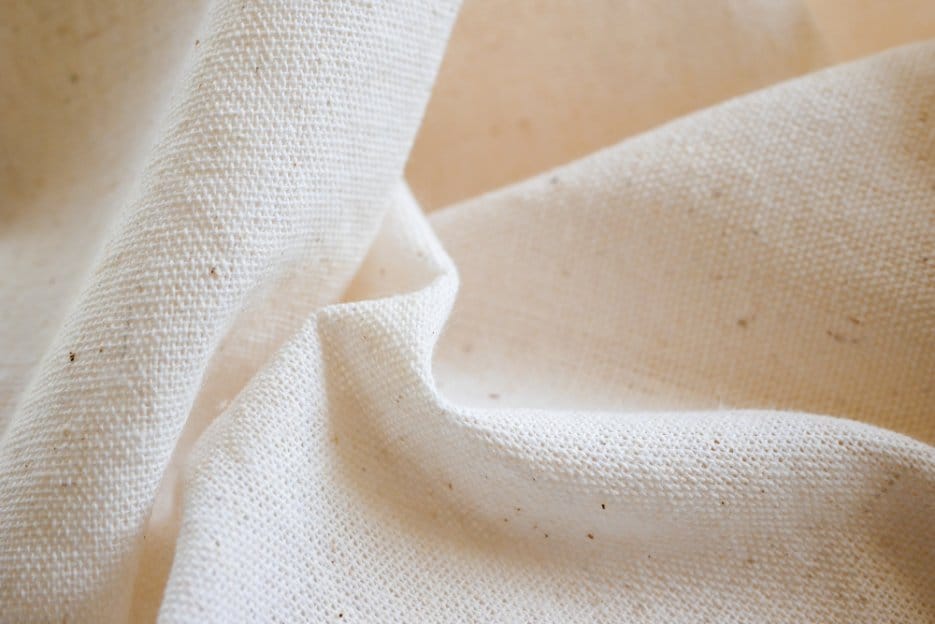
Cotton stands as one of the most versatile natural fibers in textiles. Its unique properties make it perfect for clothing and household items that touch your skin directly.
Types of Cotton You Should Know
Egyptian Cotton and Pima Cotton are premium varieties known for their extra-long fibers and superior quality. These types create softer, more durable fabrics that resist pilling and last longer than regular cotton.
Organic Cotton grows without synthetic pesticides or fertilizers. It offers a more sustainable and hypoallergenic option for people with sensitive skin.
Standard Cotton is the most common variety. It’s affordable and practical for everyday use, making up most of the cotton items in your wardrobe.
What Makes Cotton Special
Cotton fibers are made of cellulose, giving them excellent breathability and moisture-wicking abilities. Your cotton clothes can absorb up to 25% of their weight in water without feeling wet – that’s why cotton feels so comfortable against your skin.
The natural properties of cotton make it incredibly easy to clean and maintain. Unlike synthetic fabrics, you can wash cotton in hot water to remove bacteria and allergens when needed.
Cotton actually becomes stronger when wet, unlike many synthetic materials. This strength allows you to machine wash your cotton items without worrying about damage. Your cotton fabrics are also biodegradable and environmentally friendly at the end of their life cycle.
Reading Care Labels Like a Pro
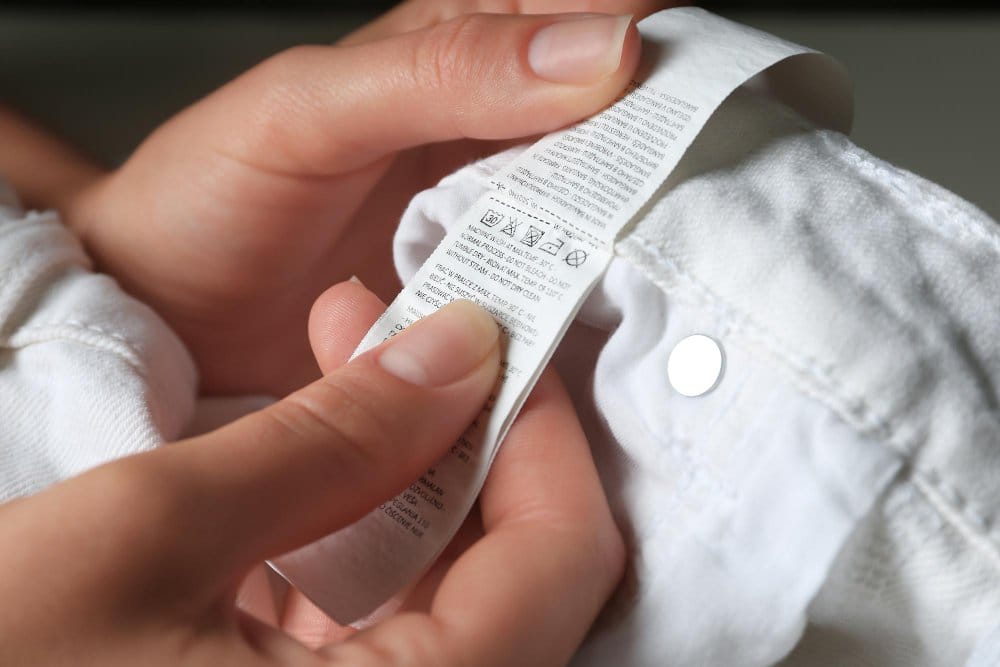
Care labels contain important symbols that tell you exactly how to wash and dry your cotton items safely. The right care keeps clothes looking fresh and lasting longer.
Decoding Those Mysterious Symbols
Care labels use five basic symbols – a washtub for washing, triangle for bleaching, iron for ironing, circle for dry cleaning, and square for drying.
The washtub symbol is most important for cotton items. Numbers inside show the max water temperature in Celsius. Lines under the tub mean gentle cycle.
Drying instructions appear as a square – either plain for air drying or with a circle inside for tumble drying. More dots mean higher heat is allowed.
Common Cotton Care Symbols:
- 40°C washtub = Warm machine wash
- Three dots in iron = High heat okay
- Plain square = Lay flat to dry
- Circle in square = Tumble dry permitted
Pay special attention to any X marks through symbols – these indicate what not to do with your garment.
Confused by care symbols? Use our interactive Care Symbol Decoder to click any laundry symbol and get instant explanations with detailed care instructions.
Can You Wash Cotton? The Complete Answer

Yes, you absolutely can wash cotton! In fact, cotton is one of the easiest fabrics to wash at home. Unlike delicate materials that need special handling, cotton is pretty forgiving and can handle regular machine washing.
How Do You Wash Cotton Properly?
The key to washing cotton successfully lies in understanding water temperature and using the right techniques. Cotton responds well to both hand washing and machine washing, depending on the specific item and your preferences.
For everyday cotton items like t-shirts, jeans, and towels, machine washing is perfectly fine. More delicate cotton pieces like vintage items or those with special details might benefit from gentler treatment.
Washing Cotton Fabric: Temperature and Techniques
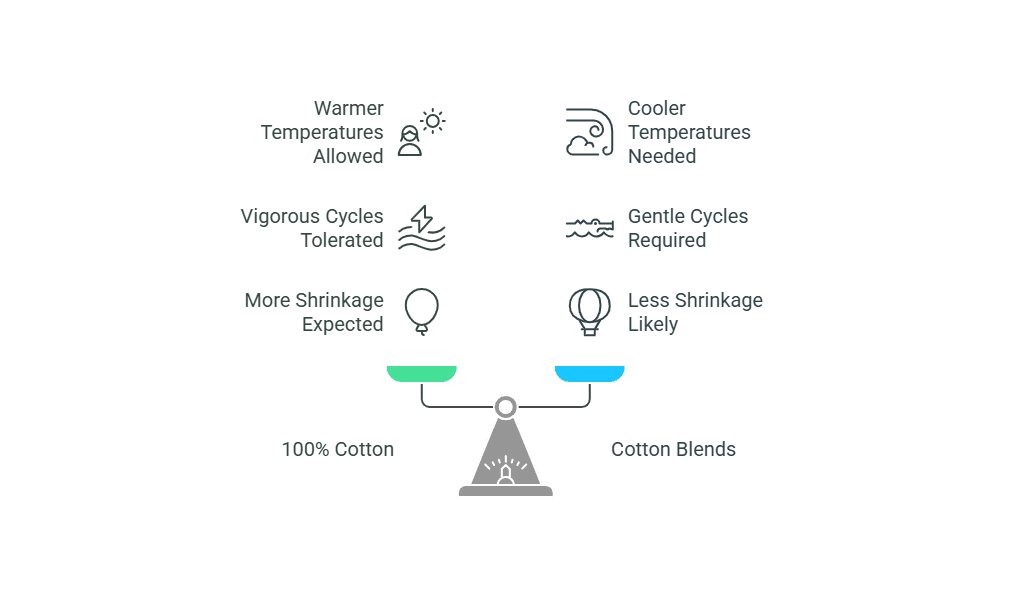
Proper washing techniques keep cotton clothes soft, vibrant, and long-lasting. Using the right water temperature, detergent type, and washing method makes a significant difference in maintaining cotton’s quality.
Water Temperature and Detergents
Cotton fabrics wash best in warm or cool water to prevent shrinkage and color fading. Hot water can damage fibers and cause excessive shrinking, so save it for white cotton items that really need deep cleaning.
Choose a mild detergent without harsh chemicals or bleaching agents. Harsh detergents can weaken cotton fibers and cause colors to fade faster.
Recommended Water Temperatures:
- Dark colors: Cold water (60-80°F)
- Light colors: Warm water (90-110°F)
- Whites: Hot water (120-140°F) only when needed
Not sure what settings to use for your specific cotton item? Our Cotton Care Calculator takes the guesswork out by providing personalized recommendations based on your fabric’s cotton percentage and weight.
How to Wash 100% Cotton vs Cotton Blends
100% cotton items are the most straightforward to wash. They can handle slightly warmer temperatures and more vigorous washing cycles than cotton blends. Pure cotton also tends to shrink more on the first wash, so expect some size reduction.
Cotton blends (cotton mixed with polyester, spandex, or other fibers) need gentler treatment. The synthetic fibers in blends can be more heat-sensitive, so stick to cooler temperatures and gentle cycles.
Washing Instructions for 100% Cotton
- Sort by color – Wash dark and light colors separately to prevent bleeding
- Check for stains – Pre-treat any spots before washing
- Use appropriate water temperature – Cold to warm for most items
- Choose the right cycle – Normal for sturdy items, gentle for delicate pieces
- Don’t overload – Give clothes room to move freely
Hand Washing vs Machine Washing
Hand washing is ideal for delicate cotton items and helps preserve their quality. Fill a clean sink with cool water and add a small amount of mild detergent.
Gently swish the garment through the water. Avoid twisting or wringing the fabric, which can stretch or damage the fibers.
Machine washing works well for everyday cotton items. Turn garments inside out before washing to protect the outer surface and reduce wear.
Gentle Cycle and Fabric Softeners
Using the gentle cycle helps prevent damage to cotton clothes. This setting reduces agitation and spinning speed, which is especially important for newer or more delicate cotton items.
Fabric softeners are optional but can make cotton clothes feel softer. Use them sparingly as they may:
- Reduce fabric absorbency
- Leave residue on clothes
- Create a waxy buildup over time
Remove clothes promptly after washing to prevent wrinkles. Shake items gently before drying to help maintain their shape.
How to Prewash Cotton Fabric
If you’re working with new cotton fabric for sewing projects, prewashing is essential. New cotton fabric almost always shrinks during its first wash, and you don’t want your finished garment to shrink after you’ve sewn it.
Prewashing Steps for Cotton Fabric
- Check the fabric care instructions first
- Wash in the same conditions you plan to use for the finished garment
- Use the same detergent you’ll use later
- Dry using your preferred method – air dry or machine dry
- Press if needed to remove wrinkles before cutting
Prewashing also removes any chemicals or finishes used during manufacturing, making the fabric softer and more comfortable against your skin.
Drying and Shrinking Concerns
Cotton fabrics need special care during drying to maintain their shape and quality. The right drying method can prevent damage and keep your clothes looking fresh.
Air Drying vs Machine Drying
Air drying is the safest way to dry cotton garments. Hang items on a clothesline or lay them flat on a clean surface. This gentle method helps cotton keep its shape and prevents fiber damage.
Machine drying works when you’re short on time. Select low heat settings and remove items while slightly damp. This reduces wrinkles and stress on the fabric.
Tips for machine drying:
- Use the gentle cycle
- Clean the lint filter
- Don’t overload the dryer
- Remove promptly when done
Preventing Shrinkage
Cold water washing and gentle drying are key to prevent cotton shrinkage. New cotton items often shrink the most during their first wash, so be extra careful with brand-new pieces.
Smart shrinkage prevention:
- Pre-wash new items before tailoring
- Use cold water settings
- Avoid high heat
- Give clothes space to move
Professional dry cleaning works well for delicate cotton pieces with special details or blends. Check garment labels for specific care instructions.
Your cotton clothes will last longer if you avoid high temperatures. Take extra care with fitted items that might be ruined by shrinkage.
Can You Iron Cotton? Ironing and Steaming Guide

Yes, you can definitely iron cotton! In fact, cotton handles heat better than most fabrics, making it relatively easy to get wrinkles out. Proper heat and moisture control are essential for removing wrinkles from cotton fabrics without damage.
Ironing Cotton at the Right Temperature
Set your iron to the high heat setting around 400°F specifically made for cotton. Always check the garment’s care label first, as some cotton blends might need lower temperatures.
Spray the fabric lightly with water or use your iron’s steam function. Damp cotton responds better to heat and pressure, making wrinkle removal much easier.
Press the iron in smooth, straight strokes while the fabric is still slightly damp. Keep the iron moving to prevent scorching or creating shiny spots.
Use firm pressure but don’t drag the iron – this can stretch the fabric. Work from the larger areas toward details like collars and cuffs.
Steaming for Wrinkle Removal
Steaming offers a gentler alternative to traditional ironing and works well for delicate cotton items. Hold your steamer about one inch from the fabric.
Move the steamer head slowly and steadily across the wrinkled areas. Keep it moving to prevent water spots from forming.
Place a lint-free cloth between the steamer and garment for extra protection against water marks. This helps distribute the steam more evenly.
Hang cotton items while steaming to let gravity help smooth out wrinkles. Allow clothes to dry completely before wearing or storing.
Maintaining Color and Softness
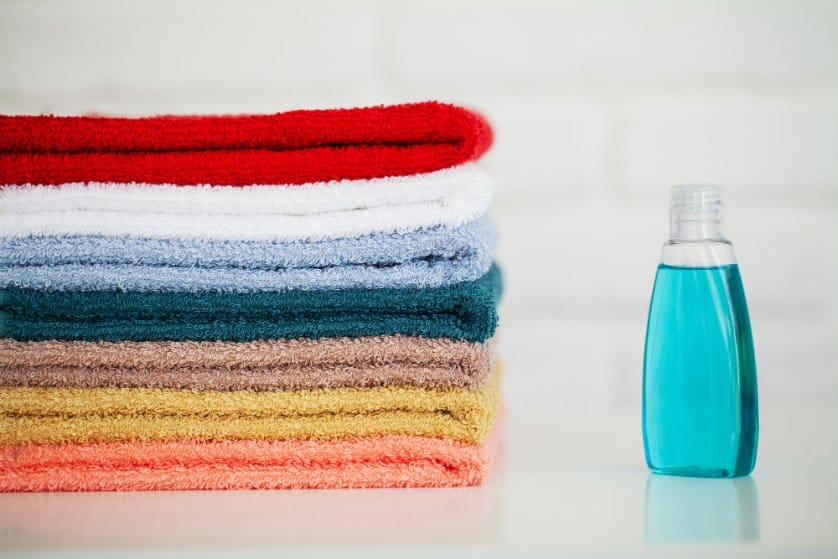
Cotton garments need specific care to stay vibrant and comfortable. The right washing techniques and products make a big difference in preserving both color and texture.
Preventing Fading and Color Bleeding
Sort your cotton laundry by color to keep bright items from staining lighter ones. Wash dark and bright clothes separately from whites and light colors.
Use cold or lukewarm water for washing. Hot water can make colors fade faster and cause shrinkage.
Turn garments inside out before washing. This protects the outer surface from friction that can cause fading.
Dry cotton clothes in the shade when possible. Direct sunlight can fade colors quickly.
Using Color-Safe Detergent and Maintaining Softness
Choose gentle, color-safe detergents made for cotton fabrics. Avoid using too much detergent – excess soap can leave residue that makes fabric stiff.
Add 1/2 cup of white vinegar to the rinse cycle. This helps remove soap buildup and keeps cotton soft and breathable.
Skip fabric softeners which can trap moisture and reduce breathability. Instead, try adding dryer balls to naturally soften clothes during drying.
Avoid over-drying your cotton items. Remove them while slightly damp to prevent stiffness and maintain their natural softness.
Can You Dye Cotton? How to Dye Cotton Fabric
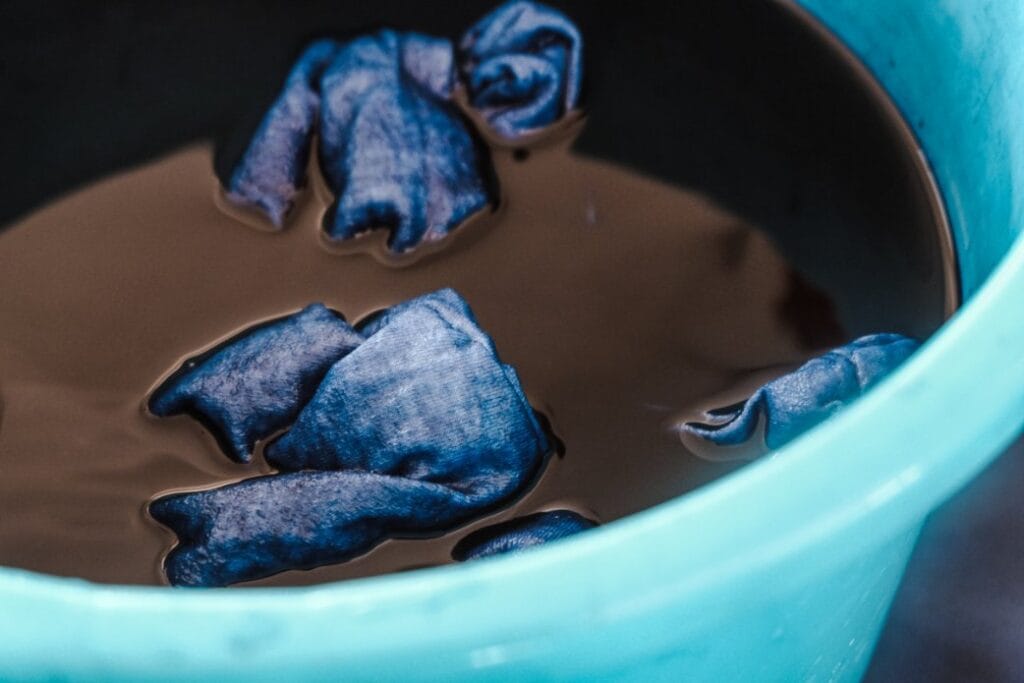
Cotton is actually one of the best fabrics for dyeing! The natural fibers absorb dye beautifully, making it possible to completely transform the color of your cotton items.
How to Dye Cotton Fabric Successfully
Choose the right dye: Fiber-reactive dyes work best for cotton and create permanent, wash-fast colors. Avoid all-purpose dyes as they don’t bond as well with cotton fibers.
Pre-treat the fabric: Wash your cotton item first to remove any finishes or residues that might prevent dye absorption. Wet fabric accepts dye more evenly than dry fabric.
Follow temperature guidelines: Most cotton dyes work best in hot water (140-160°F). The heat helps the dye molecules bond with the cotton fibers.
Use salt or soda ash: These additives help the dye bond permanently with cotton fibers. Follow your dye package instructions for the right amounts.
Rinse thoroughly: After dyeing, rinse in cool water until it runs clear, then wash separately for the first few washes to remove excess dye.
Effective Stain Removal
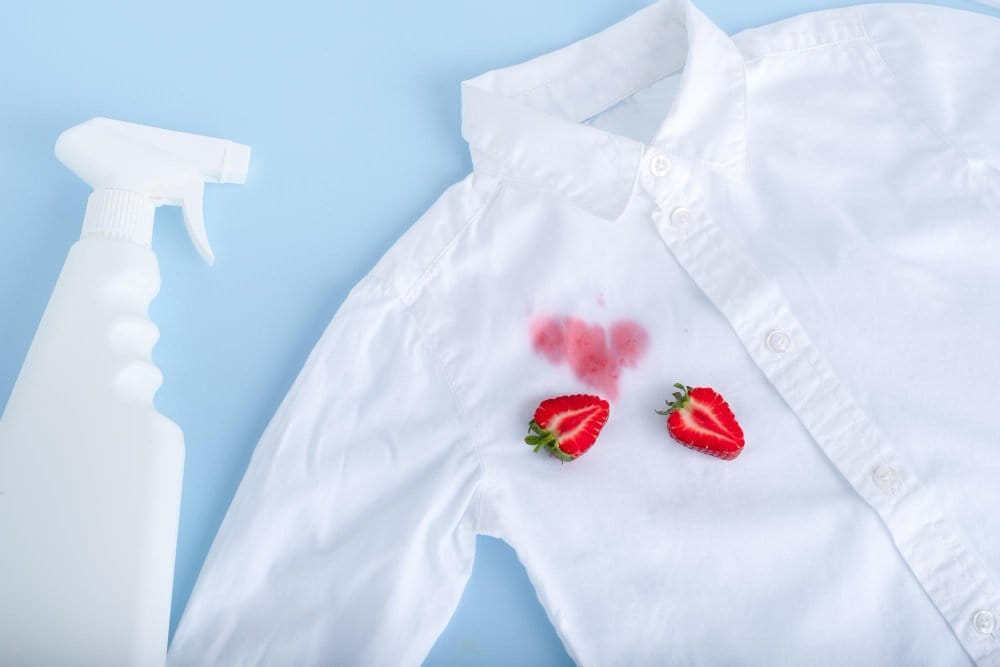
Quick stain treatment and the right techniques can save your cotton garments from permanent damage. The sooner you act and the more appropriate your method, the better your chances of success.
Immediate Actions for Stain Prevention
Always blot the stain with a clean white cloth instead of rubbing, which can spread the stain and damage fabric fibers. Remove any solid materials with a spoon or dull knife.
Pre-treat the stain immediately with cold water. Hot water can set certain stains permanently into cotton fibers.
Turn the garment inside out and rinse from the back of the stain to push it out of the fibers rather than through them.
Important Tips:
- Never put stained clothing in the dryer
- Check if the stain is gone before washing
- Test cleaning solutions on a hidden area first
Quick Action Required? For step-by-step emergency stain treatment guidance, use our Stain Emergency Guide to get instant treatment decisions based on your specific stain type.
Natural Methods for Stain Removal
White vinegar and baking soda make excellent natural stain fighters for cotton. Mix equal parts white vinegar and water, apply to the stain, and let sit for 30 minutes.
For grass or food stains, make a paste with baking soda and water. Apply gently to the stain and let it sit for 15-20 minutes.
Hydrogen peroxide mixed with dish soap works well on tough stains. Apply the mixture and let it sit for 10 minutes before washing.
Natural Stain Removers:
- Lemon juice (for rust and yellowing)
- Salt (for wine and sweat)
- Club soda (for coffee and tea)
Need immediate guidance for a specific stain? Our interactive Stain Emergency Guide provides instant step-by-step treatment instructions for different types of stains on cotton fabrics.
Proper Storage Solutions
Cotton clothing needs specific storage conditions to maintain its quality and extend its lifespan. The right storage environment and method can prevent damage and keep your garments looking fresh.
Avoiding Humidity and Light Damage
Your cotton clothes need a cool, dry space with good air circulation to prevent mildew and fabric deterioration. Store cotton garments in breathable containers like cotton or linen bags that allow airflow.
Keep your storage area between 65-75°F with humidity below 50%. Avoid basements and attics where temperature fluctuates.
Don’t expose cotton to direct sunlight, which can fade and weaken fibers. Use dark closets or drawers away from windows.
Add cedar blocks or lavender sachets to naturally repel moths and maintain freshness.
Folding vs Hanging
Heavy cotton items like sweaters and jeans should be folded to prevent stretching. Place folded garments in breathable storage containers with acid-free tissue paper between layers.
Light cotton pieces like shirts and dresses can be hung on padded or wooden hangers. Avoid wire hangers that may create shoulder bumps.
Leave space between hanging items so air can circulate. Don’t overcrowd closets or drawers.
Pro tip: Make sure clothes are completely clean and dry before storing to prevent stains from setting.
Cotton Care Comparison Chart
| Cotton Type | Water Temp | Drying Method | Iron Setting | Special Notes |
|---|---|---|---|---|
| 100% Cotton | Cold-Warm | Air dry or low heat | High (400°F) | Expect some shrinkage |
| Cotton-Poly Blend | Cold | Low heat | Medium | More heat sensitive |
| Organic Cotton | Cold | Air dry preferred | High | May shrink more initially |
| Egyptian/Pima | Cold-Warm | Air dry or low heat | High | Higher quality, longer lasting |
Quick Cotton Care Decision Flowchart
New Cotton Item?
├── Yes → Pre-wash separately
└── No → Check care label
Is it 100% cotton?
├── Yes → Can use warmer water
└── No → Use cooler settings
Dark or bright colors?
├── Yes → Cold water only
└── No → Warm water okay
Stained?
├── Yes → Pre-treat immediately
└── No → Proceed with washing
Delicate item?
├── Yes → Hand wash or gentle cycle
└── No → Normal cycle okay
Troubleshooting Common Cotton Problems
Cotton Clothes Turned Grey or Dingy
This usually happens when:
- Mixing whites with colors
- Using too much detergent
- Hard water deposits
Solution: Soak in a mixture of 1 cup white vinegar and cold water for 30 minutes, then rewash with less detergent.
Cotton Shrunk Too Much
Prevention is better than cure, but if it happens:
- Soak in lukewarm water with hair conditioner for 30 minutes
- Gently stretch while damp
- Lay flat to dry while reshaping
Cotton Became Stiff or Scratchy
Usually caused by:
- Over-drying
- Detergent residue
- Hard water
Solution: Add 1/2 cup white vinegar to rinse cycle, use less detergent, and remove from dryer while slightly damp.
Seasonal Cotton Care Tips
Summer Care
- Wash more frequently due to sweat and heat
- Use cold water to prevent color fading from sun exposure
- Air dry when possible to save energy
Winter Care
- Allow extra drying time in humid conditions
- Store summer cotton items in breathable containers
- Check stored items periodically for moisture
Cotton vs Other Fabrics: Care Comparison
Unlike polyester or synthetic fabrics, cotton is much more forgiving and easier to care for. While silk and wool require special handling, cotton can handle regular washing and higher temperatures.
Frequently Asked Questions
How should cotton clothes be washed for the first time to maintain their quality?
Pre-wash new cotton items separately before first wear. Use cold water and mild detergent to prevent color bleeding. Add 1 cup of white vinegar to the wash cycle to set dyes and remove manufacturing chemicals.
What are the specific care instructions for clothing with cotton care label symbols?
Check temperature symbols – one dot means cold wash, two dots mean warm wash, three dots indicate hot wash. Look for specific wash cycle symbols – gentle cycle shows two lines under the wash symbol. Pay attention to bleach symbols – triangle means bleach is safe, crossed-out triangle means no bleach.
What is the best practice to wash 100% cotton items in a washing machine?
Sort cotton garments by color to prevent dye transfer. Wash whites separately from colored items. Use cold or warm water with gentle detergent. Avoid overloading the machine. Turn items inside out to protect the outer surface from friction damage.
What methods prevent shrinkage when washing 100% cotton garments?
Wash cotton in cold water to minimize shrinkage risk. Hot water causes fibers to contract. Choose the gentle cycle to reduce agitation. Reshape items while damp. Pre-shrink new cotton items by soaking in cold water for 30 minutes before first wash.
What is the correct way to dry cotton clothing in a dryer to avoid damage?
Use low heat settings to protect cotton fibers. Remove items while slightly damp to prevent over-drying. Shake out wrinkles before drying. Clean the lint filter to maintain proper airflow.
What steps should be followed to hand wash cotton clothes effectively?
Fill sink with cool water and add mild detergent. Gently squeeze suds through fabric without wringing. Rinse thoroughly in clean, cool water until all soap residue is gone. Press out excess water between clean towels. Never twist or wring cotton items.
Can I wash different types of cotton together?
Yes, but sort by color and weight. Heavy cotton items like jeans can be rough on delicate cotton pieces. Wash similar weights together for best results.
How often should I wash cotton clothes?
Cotton clothing can typically be worn 2-3 times before washing, unless it’s heavily soiled or sweaty. Overwashing can cause premature wear and fading.
Why do my cotton clothes feel rough after washing?
This usually happens from over-drying, hard water, or detergent buildup. Try adding white vinegar to your rinse cycle and removing clothes while slightly damp.
Can I use bleach on colored cotton?
Only use chlorine bleach on white cotton. For colored cotton, use color-safe bleach sparingly and always test on a hidden area first.
How can I quickly understand all the symbols on my care labels?
Use our Care Symbol Decoder – an interactive tool where you can click any laundry symbol to get instant explanations. It covers washing, drying, ironing, bleaching, and professional care symbols with detailed instructions for each.
Conclusion
Caring for your cotton clothes doesn’t have to be complicated. By following these simple guidelines, you can keep your cotton items looking great and feeling comfortable for years to come. The key is understanding that cotton is a natural, durable fiber that responds well to gentle treatment and proper washing techniques.
Remember these essential takeaways: always sort your laundry by color, use appropriate water temperatures (cold for darks, warm for lights), and avoid over-drying your clothes. When in doubt, err on the side of caution with cooler temperatures and gentler cycles.
The investment in proper cotton care pays off in the long run. Well-maintained cotton clothes not only last longer but actually become softer and more comfortable with time. Whether you’re caring for everyday t-shirts or special cotton garments, these techniques will help you preserve their quality and appearance.
For those interested in learning more about different fabric types, check out our guides on how to wash and care for different fabrics and explore other natural fabric options. Understanding fabric care is an investment in your wardrobe that pays dividends in both cost savings and clothing satisfaction.
Take the time to read care labels, treat stains promptly, and store your cotton items properly. Your clothes will thank you with years of comfortable wear and lasting quality. After all, good cotton care isn’t just about following rules – it’s about developing habits that keep your favorite pieces looking and feeling their best.

